THE CROSLEY STORY
Written and Produced by G.J.Gray - 1962
Return to Main WLW page
This is the Crosley story - the story of the purchase of a birthday present for a nine-year-old boy which led to the founding of a great enterprise. After attending law school, Powel Crosley decided he was more interested in the mechanical field. He held a number of jobs in the automotive field, finally becoming an advertising salesman. In 1916, with his brother Lewis Crosley and I.J. Cooper, he started the American Automotive Accessories Company. Powel Crosley was a "promotion genius" with new ideas and a special knack of coining names to fit new ideas. Powel's brother, Lewis Crosley managed the finances and manufacturing. |
|||||
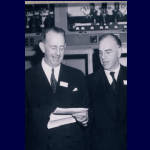
01
274.65 KB |
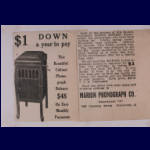
02
408.36 KB |
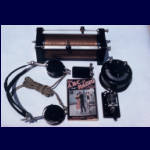
03
270.15 KB |
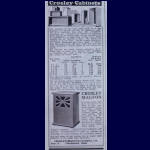
04
283.68 KB |
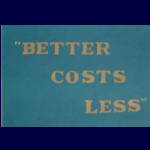
05
336.79 KB |
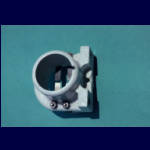
06
287.81 KB |
| 01. Powel and Lewis Crosley. 02. Using the same factory, in the winter months he built and assembled phonographs as the Marion Phonograph Company (his mother's name was Marion). A young neighbor, Tom Birch, helped Crosley's son, Powel the third, build a simple crystal radio receiver with a galena detector, headphones and an antenna made of baling wire and porcelain insulators. 03. The boy wanted a better receiver, so on his ninth birthday his father took him to the Precision Equipment Company store on Gilbert Avenue in Cincinnati, Ohio. Here he was told that a complete receiver would cost $130.00. This was too much for what Crosley considered a kid's toy. 04. In June 1925, Crosley ran this ad in Radio News magazine. Crosley's start in radio manufacturing was using his phonograph manufacturing plant to build radio cabinets. 05. One of Crosley's first slogans. It is said that Powel would come into the engineering department when everything was going ok and say, "Better costs less", but when things were going badly he would say "Better costs less". 06. One of the first radio parts was this tube socket assembled from molded porcelain selling for sixty cents when others were selling for one dollar. |
|||||
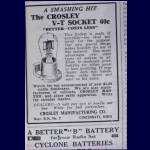
07
424.79 KB |
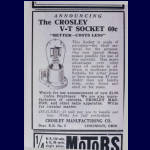
08
354.38 KB |
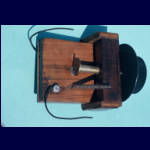
09
323.21 KB |
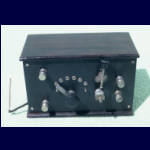
10
203.25 KB |
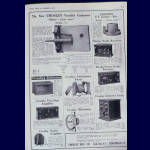
11
458.66 KB |
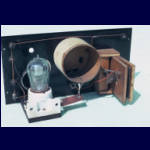
12
248.97 KB |
| 07. The first ad said "A smashing hit" until Tom Birch reminded Crosley that if you dropped a porcelain socket on the floor it would make a smashing hit. 08. The ad was immediately changed to "Announcing" the new socket. 09. Crosley hired Dorman Israel, undergraduate at the University of Cincinnati, to help design radio parts. They made the "book" condenser, sometimes called the "barndoor" condenser. This ad for an entirely new type of condenser appeared in the 1921 Radio News. Is sold for $1.25 when others sold for $3.00 and up. The two plates were plywood, surfaced with a thin copper sheet with a sheet of mica between the plates. A cam on a shaft turned by a dial operated the plate. A piece of lighter spring maintained tension on the moving plate so it would open and close like a book. 10. In October 1921, Crosley started building these crystal sets which he called the "Harko, Jr." in his cabinet factory. The men did such a poor job of assembly and soldering that girls were hired. This set employed a unique :poor man's buzzer" using a "C" battery connected through a choke made of enameled wire wound on a nail to a short piece of a hacksaw blade mounted on one edge of the front panel. The sharp teeth of the saw blade protruded from the corner of the cabinet. The other side of the battery went to a short length of bare copper wire. By scratching the wire along the saw blade you had a buzzer effect to adjust the crystal with. 11. A full-page ad in the February 1922 Radio News shows the complete Crosley line including the Model "C" condenser, tube socket, crystal receiver, Harko One tube receiver, detector unit, two stage audio unit, cabinets, rheostats. variocoupler and variometer parts. 12. One day, he realized that he was making rheostats, sockets, variable condensers and cabinets, so he had Dorman Israel wind up an 'oats box" coil to complete a one tube receiver. That night they tested it at Crosley's home in College Hill an heard Roselle Park, New Jersey and other stations. The next day they started production on the Harko Sr. receiver. Later they reached a peak production of 500 sets per day. |
|||||
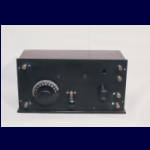
13
183.60 KB |
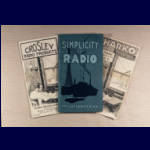
14
536.28 KB |
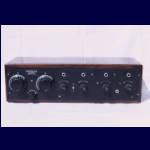
15
165.19 KB |
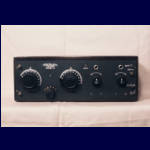
16
223.18 KB |
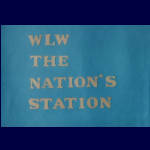
17
368.93 KB |
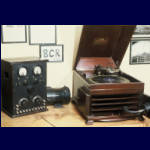
18
261.17 KB |
| 13. A front view of the Harko, Sr. one tube receiver which sold for $16.00. Later it was called the Model Five. 14. This Crosley booklet featured simple radio theory and explained features of early Crosley receivers. Although it says "by Powel Crosley, Jr." it was undoubtedly written by the engineering department. 15. This Model Ten J was an improved Model Ten. It was a four tube receiver with one stage tuned radio frequency, tuned detector and two stages of audio. A phone jack out of one stage of audio to use phones. It sold for $65.00 . The Model Six was the same without audio stages. 16. A later model, Super Six, added regeneration. A mahogany cabinet for batteries sold for $16.00. 17. Let us go back and pick up the story of Crosley's broadcast progress which was concurrent with his manufacturing operations. Another slogan was "The Nation's Station" which an announcer once fluffed to "The Nution's Stution". 18. Shortly after Crosley became interested in radio in 1921, he purchased a 29 Watt phone transmitter from the Precision Equipment Company and set it up in his home with the assigned call letters 8CR. He used one of his phonographs to play records with a telephone dispatcher's microphone in front of the record player to pick up the music. He played the record "Song of India" over and over with announcements for anyone hearing the station to call him on the telephone. Many local amateur radio operators helped with the reports. Amateur radio operators were permitted to broadcast phonograph music at this time. |
|||||
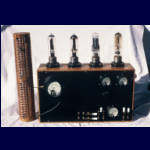
19
293.76 KB |
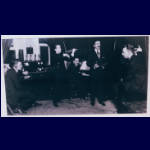
20
195.55 KB |
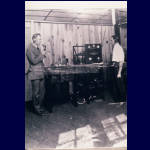
21
322.02 KB |
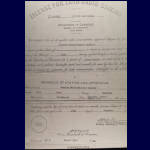
22
388.43 KB |
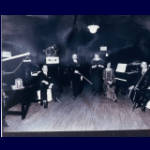
23
326.54 KB |
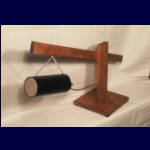
24
262.85 KB |
| 19. This small amateur effort led to the first WLW transmitter designed and built by Dorman Israel. Here is a replica off the first 100 Watt transmitter consisting of four UV203 tubes, two as modulators and two as oscillators. You can imagine what the stability and quality was like. The antenna was strung between two 40 foot downspout masts. A counterpoise was strung about six feet above the roof to improve the ground. Just before the start of the initial broadcast, Powel came to Lewis Crosley and said he wanted the antenna up to sixty feet. There was a quick rush to the roof and two ten-foot pieces of downspout were added to each mast. A Robbins and Meyer motor-generator supplied the 500 Volt plate power for the transmitter. The operating frequency was 360 meters or 833 kilocycles. 20. Here is a picture taken on the night of the first WLW broadcast, March 22, 1922 on the second floor of the factory at Blue Rock and B&O Railroad. The engineer on the left with the transmitter is Paul Ewing, Crosley advertising man. The three musicians were from the Cincinnati Conservatory of Music. Powel Crosley, on he right, is holding the pickup phonograph horn with a telephone dispatcher's microphone mounted at the end. 21. Later, when WLW was moved to the Alfred and Cook Street plant, the power was increased to 500 Watts with UV204 tubes replacing the UV203s. A specially built 1600 Volt motor-generator supplied the plate power. The motor-generator was located in the basement with a high voltage line running to the transmitter on the second floor. A 1600 Volt bank of Willard storage batteries was used for "standby" service. The shelf at the top of the transmitter rack was the "expansion attic" where four extra UV204s were mounted for quick wiring into the circuit to double the power and quicker unwiring to tell the radio inspector that this was the storage place for spare tubes. At this time operation was on 309 meters or 970 kilocycles. 22. WLW license dated August 31, 1922 23. Powel Crosley was WLW's first announcer. One day Fred Smith came in to talk about programming and became the first full time announcer, program arranger and general studio handyman. Here he is seated on the left with a group of musicians from the Cincinnati Conservatory of Music. Much of the early WLW music talent came from the Conservatory. The sign on the left says "Talk-Sing-Play-Softly", probably to protect the "tomato can" microphone. The sign on the drape says "silence must prevail when this is lighted." 24. Spring mounted microphone. |
|||||
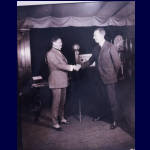
25
281.95 KB |
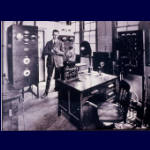
26
342.79 KB |
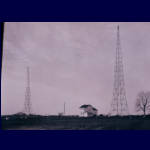
27
250.71 KB |
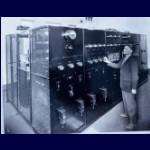
28
334.46 KB |
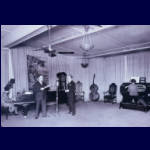
29
361.98 KB |
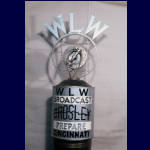
30
331.13 KB |
| 25. Powel Crosley with cartoonist, Sidney Smith, creator of Andy Gump in early WLW studio. Interviews on broadcast stations with well known people started early in the 1920's.. 26. Powel Crosley reading the dedication message on the new Western Electric 500 Watt transmitter located at Alfred and Cook Streets in Cincinnati. On April 11, 1923, letters and telegrams were received showing that the broadcast was heard in every state, Canada, Mexico and foreign countries. After the broadcast Crosley had the satisfied feeling of having provided an evening of entertainment for hundreds of thousands of people. 27. The farm house plant in Harrison, Ohio for the new 1925 WLW transmitter. Here are the new 200 ft. towers supporting the flat top antenna. Operating frequency was 710 kilocycles. 28. Joe Whitehouse, chief engineer, tuning the Western Electric 5000 Watt transmitter located 22 miles from the studio. This was the first broadcast transmitter known to be operated remote from the studio's Harrison, Ohio. 29. These spacious studios, located on the first floor of the Crosley plant at Colerain and Sassafras Streets were of the latest design in the broadcast field in 1925. The Mills brothers started here in 1926 to launch WLW as "The Cradle of Stars." Betty and Rosemary Clooney, Andy Williams, Jane Froman, Eddie Albert, and many others started their careers at WLW. This is musical director William Stoess and announcer Louis Jon Johnan. 30. Double button carbon microphone on a special stand. The window at the top had the word "broadcast" and the opening at the bottom had "prepare." The studio engineer could light the appropriate sign from the control room. |
|||||
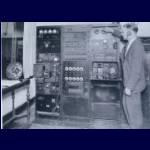
31
428.92 KB |
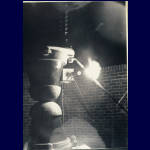
32
285.01 KB |
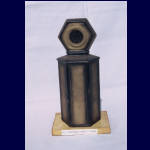
33
247.49 KB |
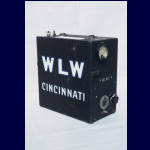
34
237.11 KB |
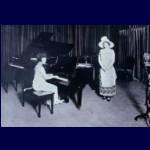
35
314.93 KB |
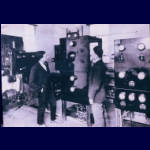
36
370.76 KB |
| 31. Master control room with the late Dave Conlon monitoring the program on the air. The Morse telegraph equipment was used for quick communications with the network. The Crosley speaker was a studio monitor. 32. Antenna insulator at the base of the 831 foot tower, WLW. Mason, Ohio arcing over. 33. This Crosley built condenser microphone was used in the 1928 studios. 34. Pack transmitter used on 27 megacycles with the call letters WLWE to broadcast remote programs to the receiving antenna located on the Carew Tower in downtown Cincinnati. The program went then to the Arlington Street studios by land line (telephone). This unit was designed and built by Robert Booth, W3PS, who later became legal counsel for the American Radio Relay League, WLWE was used for many WLW broadcasts of the Cincinnati Reds games from Crosley field. 35. Crosley acquired WSAI from the United States Playing Card Company in 1928 and by this deal got the present location for the WLW transmitter. This is a view of a WSAI studio in Norwood, Ohio 1923. The dresses are somewhat longer than the present "mini" skirts. WSAI became known as Cincinnati's own station. 36. Early shortwave transmitter. |
|||||
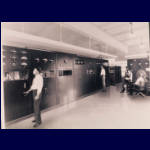
37
259.08 KB |
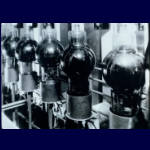
38
308.42 KB |
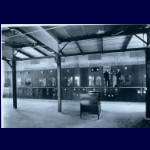
39
362.24 KB |
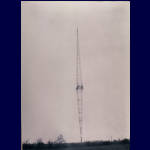
40
232.13 KB |
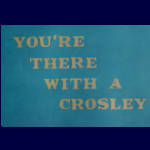
41
339.40 KB |
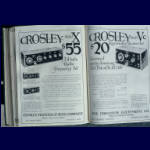
42
445.95 KB |
| 37. In 1927, Crosley got a clear channel on 700 kilocycles and in 1928 installed the 50 kilowatt Western Electric transmitter at the present Mason, Ohio site. The first WLW broadcast from the Mason, Ohio location was October 28, 1928. 38. Six RCA 870 rectifiers, hot cathode, mercury vapor tubes supplied 12 kilovolts at 110 amperes for the 500 kilowatt transmitter at 100% modulation. 39. View of the massive 500 kilowatt WLW transmitter. Joe Joe Chambers, director of broadcasting engineering and Joe Whitehouse, WLW chief engineer, are shown on the catwalk with one of the high power tubes. 40. WLW antenna tower at Mason, Ohio. Height 831 feet. 41. "You're there with a Crosley" was another slogan that appeared in many Crosley ads. We now return to the receiver side of the story. 42. Crosley realized that he would have to get an Armstrong regenerative patent license to make the receivers more sensitive and selective. In the fall of 1923 he purchased the Precision Equipment Company from John L. Gates to get the patent license and also to acquire station WMH. He turned in the WMH call letters but used the allotted time on WMH to increase WLW operation. WLW and WMH shared air time at this time. Double page ads in May 1923 Radio News showed Crosley Manufacturing Company on one side and Precision Equipment Company ad on the other side with Powel Jr. as president. |
|||||
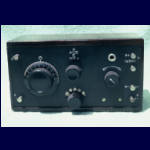
43
235.01 KB |
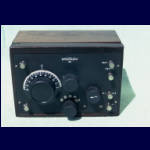
44
251.04 KB |
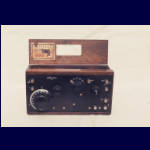
45
244.99 KB |
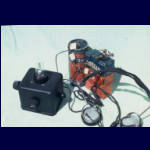
46
307.46 KB |
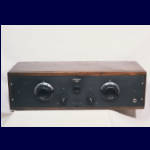
47
195.12 KB |
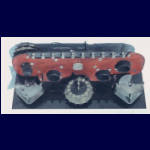
48
190 KB |
| 43. The first one tube regenerative receiver produced by Crosley but sold under Ace trademark. 1922-23. 44. In a short time the Crosley line included the model 50, one tube Armstrong licensed regenerative receiver. 1924. 45. Model 51, regenerative detector and one stage of audio amplifier. This was a very popular model. 1924. 46. Working toward a low cost market in 1925 Crosley produced the famous Crosley Pup, compact, cheaper version of the model 50 to sell for $9.95 without accessories. This cheaper receiver gave many low income people the fun of radio reception in their homes. Two singers on WLW at this time sang "We Are the Crosley Pups" and entertained to advertised this receiver. 1925. 47. The 3R3 or Trirdyn model, featured radio frequency, regeneration and reflex, the 3 R's where 3 tubes did the work of 5 tubes. The regular sold for $65.00. The "special" in larger cabinet for $75.00 and the "Newport" with space for batteries for $100.00. The Trirdyn was a very popular model and was produced in many models. 1924. 48. Later improved models of the Trirdune featuring this deluxe chassis were called super Trirdyne in regular - special and Newport models. |
|||||
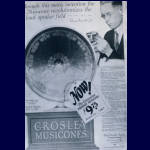
49
473.97 KB |
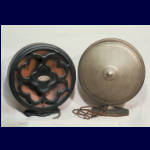
50
276.20 KB |
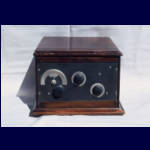
51
249.16 KB |
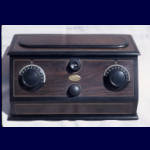
52
316.17 KB |
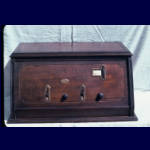
53
350.08 KB |
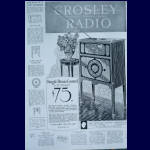
54
527.06 KB |
49. One day an inventor named Peterson came to Powel's office with a speaker wrapped in newspaper. He had been turned down by other manufacturers but Crosley signed a contract with royalties based on distributors cost. Many thousands of these were sold. 50. The original Musicone is on the right with the improved model "D" on the left. The 12" model sold for $9.75 and the 16" Supermusicone sold for $14.75. The Musicone cone speakers were the first low priced speakers on the market. 51. The Super 51 was a deluxe model with a larger cabinet to house batteries, new style dials, sloping panel, and inside connections. The regeneration control was improved by the use of slotted spiral rod. 1924. 52. The 4-29 1926 model with one state of RF, detector and 2 stage audio. The lower knob in the center is the regeneration control and is called the Crescenden. Used 199, 201A or WD12 tubes. Sold for $29.00. 53. The Model 5-50 sold for $50.00, featured a metal chassis, five tubes, single dial control with space for writing in call letters. Cresenden and two acuminators. These were simply padding condensers for manually aligning the condenser sections. 54. The 5-75 console featured the 5-50 chassis with the Musicone speaker in a mahogany cabinet. $75.00. |
|||||
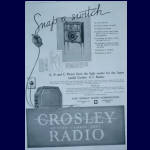
55
346.47 KB |
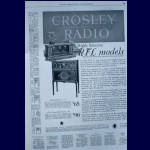
56
519.70 KB |
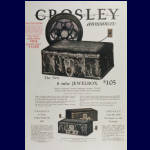
57
382.83 KB |
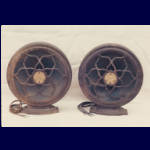
58
303.38 KB |
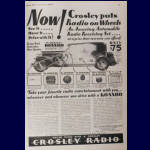
59
449.82 KB |
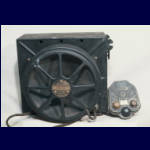
60
234.00 KB |
| 55. The Crosley socket power was the first step from the battery to complete AC operation. Messy storage batteries requiring a lot of attention and expensive "B" battery replacement became a thing of the past. 1928. 56. The RFL models were manufactured under Radio Frequency Laboratories license. Early 1926 models were the RFL-60, five tube table model with artistic and decorative Formica panels. The early RFL-75 used the same chassis in a sloping panel cabinet. This ad appeared in Radio Broadcast Advertiser, December 1626, and featured the RFL-75 with two tone mahogany cabinet, sloping wood panel and recessed dials. The six tube RFL-90 console model featured double drum station selector with two acuminators and a Musicone speaker in a two tone mahogany cabinet. 57. In 1928, the jewel box was produced with the Neutrodyne circuit, metal cabinet and all AC operation. The 602 unit used a separate AC supply and the 704 was self contained for AC operation. The 30 microfarad Mershon wet filter condenser was used and manufactured by Amrad. Crosley later bought the Amrad Company, produced sets under the Amrad name and later liquidated the company. 58. The Musicone speaker was redesigned to use a field winding which served as a choke in the power supply circuit. Later the housing was changed slightly, a heater and a motor were added to sell as the Temperator. 59. The Roamio was one of the first automobile radios in 1930. A large metal box housed the "B" batteries and was mounted in a hole cut out in the floor board. A chicken wire antenna was mounted under the cloth liner in the roof. 60. The receiver unit was mounted on the firewall. Control panel "B" could be mounted permanently into the dash of the car or control panel "A" could be clamped on the bottom edge of the dash. A key turned the set on and off and could be removed so that the set could not be operated and the battery run down. |
|||||
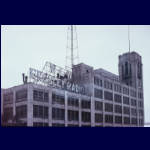
61
314.72 KB |
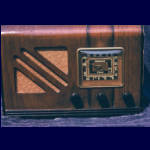
62
553.17 KB |
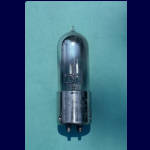
63
251.57 KB |
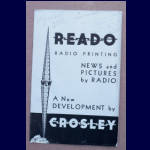
64
136.26 KB |
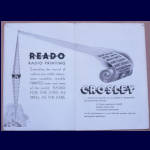
65
167.31 KB |
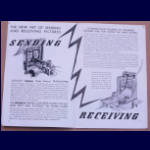
66
253.46 KB |
| 61. This new plant, built in 1927, was an addition to the Colerain and Sassafras plant. It fronted on Arlington Street and housed executive and general offices, engineering and production. An additional building across Arlington Street called Building "K" housed the refrigeration production. The Arlington Street studios were on the eighth floor. 62. One of the last AC Crosley Fivers was used in the Lewis Crosley home. The early one tube Harko was called a Model Five and the Crosley line always carried a "Fiver", the lowest price unit in the line. 63. This is a very rare Crosley tube, RCA tried to cut off Crosley's use of the Armstrong license but lost the case in court. Crosley feared his source of tubes would be cut off in reprisal so he set up a small manufacturing plant with Russ Blair in charge. Very few tubes were produced. Crosley later bought the Kenrad Tube Co in Owensboro, Kentucky. This tube was called a deflectron tube. It was different in that it had its grid placed at one side of the filament and this way deflected the electron stream away from the plate of the tube. In tubes of this time, 1924, the grid was placed in the tube to block the electron stream. 64-70. Crosley Reado radio printing news and pictures by radio (Facsimile). Powel Crosley read the World War II news at his home each morning by Reado in the early 1940's, the first in use. |
|||||
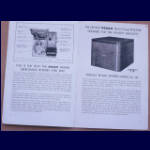
67
255.68 KB |
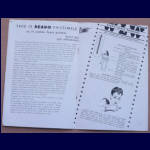
68
258.16 KB |
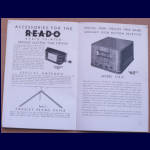
69
211.53 KB |
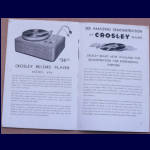
70
231.41 KB |
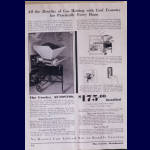
71
472.85 KB |
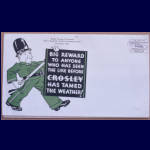
72
155.74 KB |
| Crosley believed in diversifying his business and produced a number of non-radio items. Here are a few. 71. Autostock. This was a coal stoker. 72-77. Advertising for the Crosley Coolrest, an invention to keep a bed cool. |
|||||
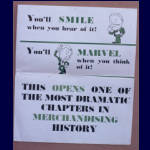
73
150.71 KB |
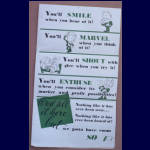
74
215.81 KB |
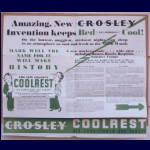
75
243.72 KB |
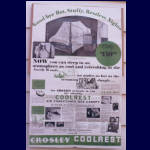
76
298.23 KB |
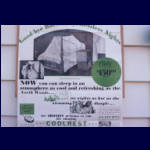
77
330 KB |
|
|
|
|||||